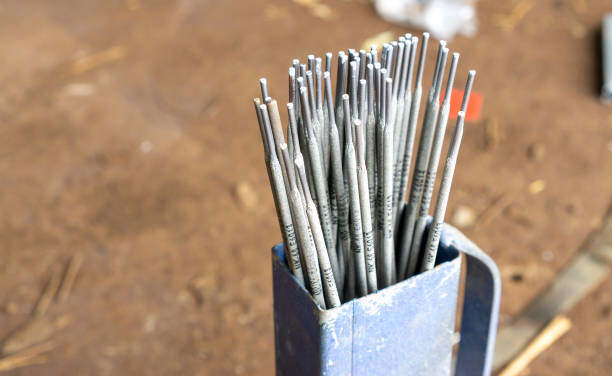Arc welding, a fundamental process in the world of metal fabrication, relies heavily on the choice of electrodes. The right electrode can make a significant difference in weld quality, efficiency, and overall performance. In this guide, we address frequently asked questions surrounding arc welding electrodes, including their types, selection criteria, and the factors that contribute to achieving impeccable welds.

I. Which Electrode is Used in Arc Welding?
The choice of electrode in arc welding is a critical decision that influences the outcome of the weld. Different electrodes serve varying purposes, and their characteristics can significantly impact the welding process. Here are some commonly used types:
E6010 Electrode: Known for its deep penetration capabilities, the E6010 electrode is often used in root passes in pipe welding. It operates on direct current (DC) and is suitable for welding in challenging positions.
E7018 Electrode: This low-hydrogen electrode is highly versatile and provides excellent strength and ductility. It is commonly used for structural welding in industries such as construction and bridges.
E308 Electrode: Designed for welding stainless steel, the E308 electrode offers corrosion resistance and is suitable for applications where maintaining the integrity of the stainless steel is crucial.
E6013 Electrode: Ideal for light to medium-duty welding, the E6013 electrode is known for its ease of use and all-position welding capabilities. It produces a smooth and clean weld bead.
E7014 Electrode: With a high iron powder content, the E7014 electrode provides increased deposition rates and is often used for welding in situations where higher speeds are required.
II. Factors in Selecting Arc Welding Electrodes
Choosing the right arc welding electrode involves a careful evaluation of several key factors. The following considerations will guide you in making an informed decision for your welding projects:
Coating Type: Electrodes are coated to provide protection against atmospheric contamination and improve the stability of the arc. Common coatings include rutile, cellulose, and basic. Each has its advantages and is suitable for specific applications.
Diameter of Electrode: The diameter of the electrode influences the welding current and deposition rate. Thicker electrodes are suitable for higher welding currents and faster deposition rates, while thinner electrodes are preferred for lower currents and intricate welds.
Welding Position: Consider the welding position required for your project—electrodes are classified based on their suitability for flat, horizontal, vertical, or overhead welding.
Hydrogen Content: Low-hydrogen electrodes are crucial when welding materials susceptible to hydrogen-induced cracking, such as high-strength steels. The level of hydrogen in the electrode coating can impact the mechanical properties of the weld.
Storage and Handling: Proper storage and handling of electrodes are essential to prevent moisture absorption and maintain their integrity. Follow manufacturer recommendations for storage conditions.
III. What is the Best Electrode for Arc Welding?
The concept of the "best" electrode in arc welding is subjective and depends on the specific requirements of the welding project. Different electrodes excel in various applications, and selecting the best one involves considering factors such as material type, welding position, and desired weld characteristics. Here are some general guidelines:
1. Material Compatibility:
Mild Steel: Commonly welded with E6010, E6011, E6013, or E7018 electrodes.
Stainless Steel: Requires electrodes such as E308, E309, or E316, depending on the specific stainless steel grade.
2. Welding Position:
3. Current Type:
4. Coating Type:
Cellulose-Coated Electrodes: Provide deep penetration and work well in all positions.
Rutile-Coated Electrodes: Offer good stability and are suitable for thin materials.
Basic-Coated Electrodes: Ideal for high-strength and low-alloy steels.
IV. Use Megmeet Welders and the Right Arc Welding Electrodes to Achieve Excellent Welds
For welders seeking top-notch performance and cutting-edge technology in welding equipment, Megmeet Welding stands as a beacon of excellence. With a commitment to innovation and quality, Megmeet Welding provides a range of welding solutions that cater to the diverse needs of welders across industries.
V. Megmeet Welding: Your Trusted Partner in Welding Excellence
Visit Megmeet Welding to explore a world of welding solutions designed to elevate your welding experience. Megmeet Welding offers a comprehensive range of welding machines (including MIG/MAG/TIG/Laser welders), ensuring that welders have the tools they need to achieve exceptional results.
VI. Conclusion
Arc welding electrodes play a pivotal role in the success of any welding project. By understanding the different types of electrodes, the criteria for selecting the best one, and the factors that contribute to their effectiveness, welders can make informed decisions that lead to impeccable welds. Whether you're working on structural projects, pipe welding, or intricate stainless steel applications, the right electrode, combined with skill and precision, can make all the difference.
For state-of-the-art welding equipment and solutions, trust Megmeet Welding to provide the tools you need to excel in your welding endeavors. Visit Megmeet Welding today and take a step towards welding excellence.
Related articles
1. How To Shape Tungsten Electrode For TIG Welding?
2. How to Identify and Solve Tungsten Electrode and Arc Issues
3. Arc Welding vs. Laser Welding: The Key Differences
4. Shielded Metal Arc Welding (SMAW): The Beginner's Guide
5. Why DC Arc Welding is More Used than AC Arc Welding in Specialized Applications?




